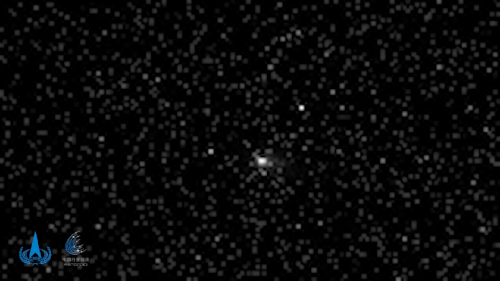China's Tianwen 1 Mars probe captures images of interstellar comet 3I/ATLAS
Tianwen 1 has spotted the solar system's latest interstellar intruder from Mars orbit.

China's Tianwen 1 Mars orbiter has imaged the interstellar comet 3I/ATLAS during its close pass by the Red Planet, aiding global efforts to study the rare interstellar interloper.
3I/ATLAS is only the third object ever confirmed to have reached our solar system after originating in another planetary system, following 'Oumuamua in 2017 and 2I/Borisov in 2019. This time, space agencies around the world have been looking at any and all ways to study the invading comet, including repurposing spacecraft spread across the solar system.
The European Space Agency and NASA are known to have pointed their Mars spacecraft, including surface rovers, toward the comet when 3I/ATLAS, which is thought to be older than our solar system, passed by in early October. And now the China National Space Administration (CNSA) has revealed that its own Tianwen 1 spacecraft imaged the comet between Oct. 1 and Oct. 4, publishing images showing its path during this time, as well as a standalone photo from Oct. 3.

Tianwen 1 used its High-Resolution Imaging Camera (HiRIC) — somewhat comparable to HiRISE on NASA's Mars Reconnaissance Orbiter (MRO), but slightly lower resolution — to capture the comet moving against a stellar backdrop. The operation posed challenges, notably switching from imaging bright planetary surface features from low Mars orbit to tracking, from 18 million miles (28.96 million kilometers) away, a faint comet that's moving at 129,800 mph (58 km per second) and is just 3.5 miles (5.6 km) wide.
"Data acquired by a high-resolution camera was received, processed and displayed by a ground-based application system," according to CNSA's Nov. 5 statement. "The images clearly show the comet's distinctive features, consisting of a nucleus and a surrounding coma, with a diameter reaching several thousand kilometers."
CNSA says the comet imaging project was an important extension mission for Tianwen 1, stating that the ability to observe faint celestial bodies provided a chance to perform useful technical tests and accumulate experience for the second mission in China's deep-space exploration series, Tianwen 2, which launched in May and is on its way to sample a near-Earth asteroid.
Tianwen 1 is China's first planetary exploration mission. It launched in July 2020 and entered Mars orbit in February 2021. The mission's Zhurong rover successfully landed in Mars' Utopia Planitia region in May 2021 and operated on the surface for around one Earth year.
Breaking space news, the latest updates on rocket launches, skywatching events and more!

Andrew is a freelance space journalist with a focus on reporting on China's rapidly growing space sector. He began writing for Space.com in 2019 and writes for SpaceNews, IEEE Spectrum, National Geographic, Sky & Telescope, New Scientist and others. Andrew first caught the space bug when, as a youngster, he saw Voyager images of other worlds in our solar system for the first time. Away from space, Andrew enjoys trail running in the forests of Finland. You can follow him on Twitter @AJ_FI.
You must confirm your public display name before commenting
Please logout and then login again, you will then be prompted to enter your display name.
